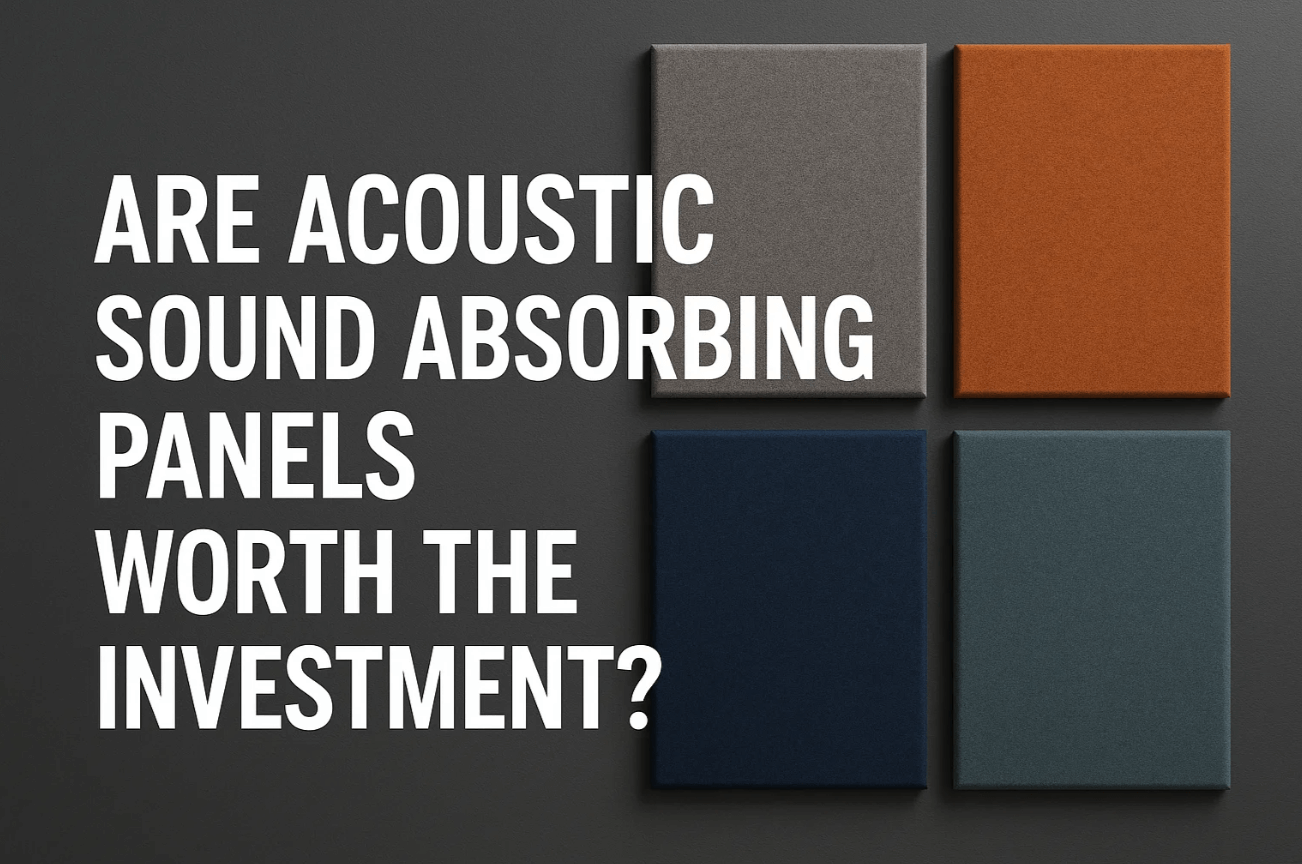Are Acoustic Sound Absorbing Panels Worth the Investment?
Noise levels inside modern buildings are climbing. Open‑plan offices buzz with phone calls, cafés echo with clinking cups, and home studios wrestle with street traffic. Acoustic sound absorbing panels are a fast, low‑mess way to tame that din so people can focus, relax, or create. As a factory‑direct wholesaler, Wellco Wholesale stocks a full range of acoustic treatments alongside garden, farm, and light‑building supplies, offering bulk pricing that helps trade customers stretch their budgets while still meeting one‑off DIY orders. This guide unpacks what the panels do, who benefits most, what they cost, and how to choose the perfect fit for your project.

What Are Acoustic Sound Absorbing Panels and How Do They Work?
The Science of Sound Absorption
Every surface either reflects or absorbs sound. Panels built from porous or fibrous materials convert acoustic energy into tiny amounts of heat, lowering reverberation time. In controlled laboratory tests, adding wall‑mounted panels dropped average RT60 (the time it takes sound to decay by 60 dB) by 30–50 %, improving speech clarity and reducing listener fatigue. A quick spec to check is NRC—Noise Reduction Coefficient. An NRC of 0.70 means the panel absorbs 70 % of incident sound energy across key speech frequencies; higher is better for critical‑listening rooms.
Common Panel Materials & Constructions
-
Recycled PET felt: lightweight, formaldehyde‑free, available in vibrant colors.
-
Mineral‑wool core with fabric wrap: high NRC (0.85–1.00) and Class A fire rating.
-
Wood‑fiber bound panels: add natural texture while absorbing mid‑range frequencies.
-
Perforated wood or MDF backed with acoustic fleece: balances diffusion and absorption.
Wellco’s catalog includes all of the above plus custom‑cut ceiling baffles for projects that need both style and performance.
Who Benefits Most: Key Applications & Outcomes
Open‑Plan Offices & Coworking Spaces
A Stanford behavioral study found that employees exposed to noise levels above 55 dB lost 15 % of measurable productivity compared with peers in acoustically treated rooms. Panels installed on conversation hot spots—above conference tables or between desk pods—lower background chatter so teams spend less energy simply hearing one another.
Hospitality, Classrooms, and Retail
“Guests rarely describe a space as ‘too quiet,’ but they frequently complain when it’s too loud,” notes interior designer Maya R., whose boutique hotel refurbishment used fabric‑wrapped panels disguised as artwork. Post‑stay surveys showed a 22 % bump in customer‑satisfaction scores after installation. In classrooms, research from the Acoustical Society of America links better test performance to lower reverberation, emphasizing the role of sound absorption in equitable learning.
Home Studios & DIY Media Rooms
Audio engineer Carlos Mendoza shares first‑hand advice: “Start with the mirror points—the walls where sound bounces straight back to your ears. Even four 2‑inch mineral‑wool panels can tighten bass and clean vocals.” Because acoustic sound absorbing panels can be moved or upgraded later, hobbyists can grow their setup without sinking the cost of full‑frame construction.
Cost vs. Value: Are Panels Worth the Investment?
Up‑Front Costs Explained
Retail pricing ranges from $8–$18 USD per square foot for premium fabric‑wrapped boards, but buying factory‑direct through Wellco Wholesale drops costs by up to 35 % in pallet quantities. Don’t forget mounting clips (about $0.50 each) and the value of your time if you self‑install.
Long‑Term ROI
Beyond quieter conversations, facilities that addressed acoustics saw a 20 % drop in employee turnover within a year—worth thousands in rehiring expenses. Some panel types double as thermal insulation, cutting HVAC loads by up to 5 %, according to an ASHRAE field study, further improving payback.
Anonymized Case Study: Converting a Warehouse Office
A regional logistics firm retrofitted 1,500 ft² of corrugated‑steel office space. After installing PET felt panels on 40 % of wall area and adding ceiling baffles, measured sound‑pressure levels fell from 68 dB to 54 dB. The calmer environment reduced error‑correction calls by 18 %, paying back material costs in just three months.
Selecting the Right Panels: Expert Buying Checklist
Performance Specs That Matter
-
NRC ≥ 0.80 for spaces where speech is critical.
-
Thickness – two‑inch panels absorb lower frequencies than one‑inch.
-
Fire rating – look for ASTM E84 Class A or EN 13501 B‑s1‑d0 to satisfy code.
Installation Options: DIY vs. Professional
-
DIY: Use Z‑clips or peel‑and‑stick strips; a typical room installs in under two hours.
-
Pro install: Necessary for high ceilings, sprinkler interference, or seismic codes. Labor averages $3–$6 per sq ft.
Hidden costs to budget: paint touch‑ups, lift rentals, and after‑hours scheduling where noise work disrupts business.
Sustainability & Certifications
Eco‑conscious buyers should seek panels with GREENGUARD Gold certification and at least 50 % recycled content. PET felt excels here, and Wellco can provide documentation for LEED credits.
How Wellco Wholesale Adds Value to Your Acoustic Project
Factory‑Direct Sourcing & Custom Orders
Because Wellco works straight with panel manufacturers, you can specify bespoke shapes, printed graphics, or non‑standard thicknesses without the usual distributor mark‑ups.
Volume Discounts and Flexible MOQs for Trade Buyers
Need ten panels for a podcast booth or a thousand for a school district? Tiered pricing and mixed‑container loads mean you only pay for what you need.
Logistics, Lead Times, and After‑Sales Support
-
Global FOB or DDP shipping with in‑house export documentation.
-
Typical lead time: 10–15 business days for stocked SKUs, 20–25 for custom colors.
-
Every shipment includes a panel‑care guide and access to live tech support if you have install questions down the road.
Conclusion
Effective noise control is not a luxury—it is a measurable performance upgrade. By understanding how acoustic sound absorbing panels function, matching material specs to your goals, and leveraging factory‑direct pricing from Wellco Wholesale, you can create calmer, healthier spaces that pay for themselves faster than most ergonomic chairs. Ready to hear the difference? Buy it now or request a tailored quote from the Wellco team today.
Frequently Asked Questions
Q1: How many panels do I need for a standard 10 ft × 12 ft office?
Start by covering roughly 25 % of the combined wall and ceiling area; six 2 ft × 4 ft panels is a common starting point. Measure reverberation afterward and add more if needed.
Q2: Can I mount panels on concrete or brick walls?
Yes. Use masonry anchors or construction‑grade adhesive pads rated for the panel weight. For heritage walls, consider freestanding screens to avoid drilling.
Q3: Do acoustic panels also block sound between rooms?
They primarily absorb sound within a room. To block transmission, combine panels with mass‑loaded vinyl or additional wall layers.
Q4: Are there moisture‑resistant options for basements or indoor pools?
Look for PET felt or perforated aluminum‑face panels with a hydrophobic core. Always allow an air gap so trapped humidity can vent.
Q5: What is the typical lifespan of acoustic panels?
Quality panels last 10–15 years. Vacuum fabric faces periodically and inspect mounting hardware yearly to maintain performance.

